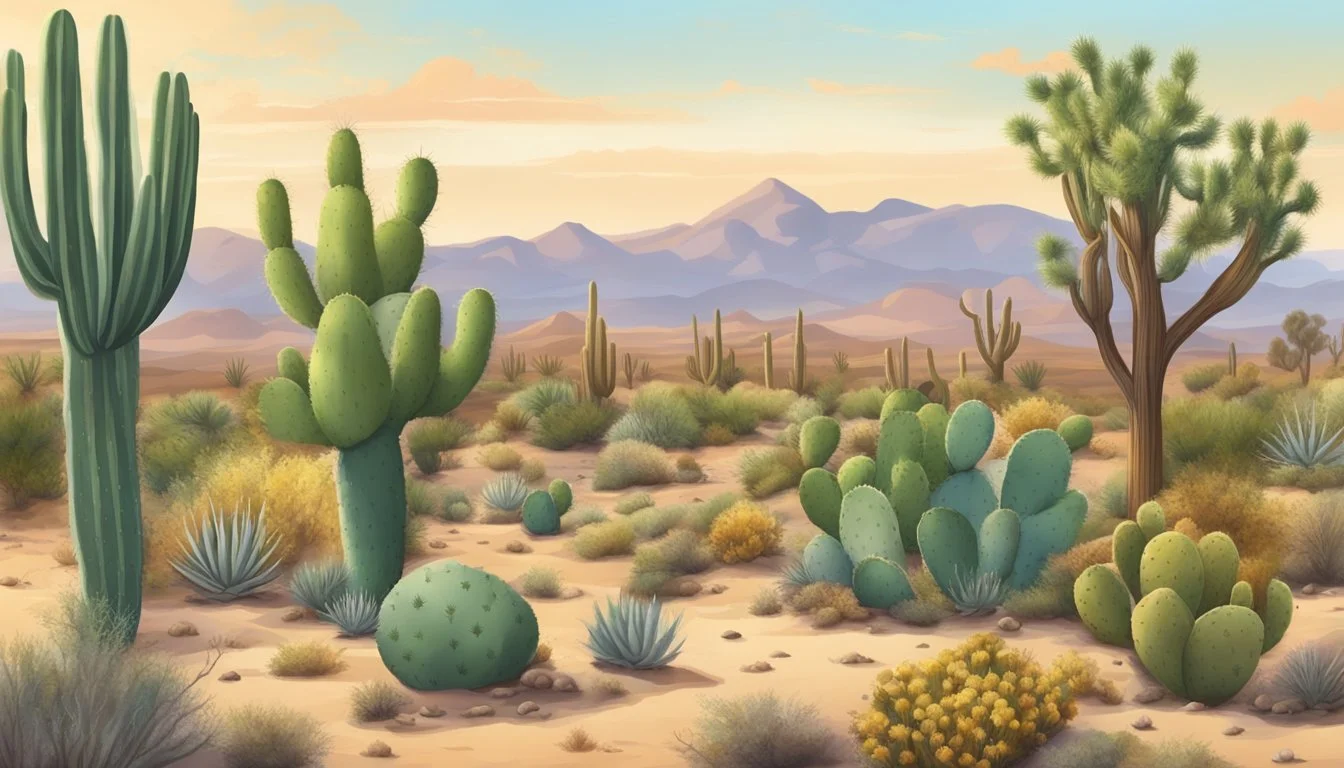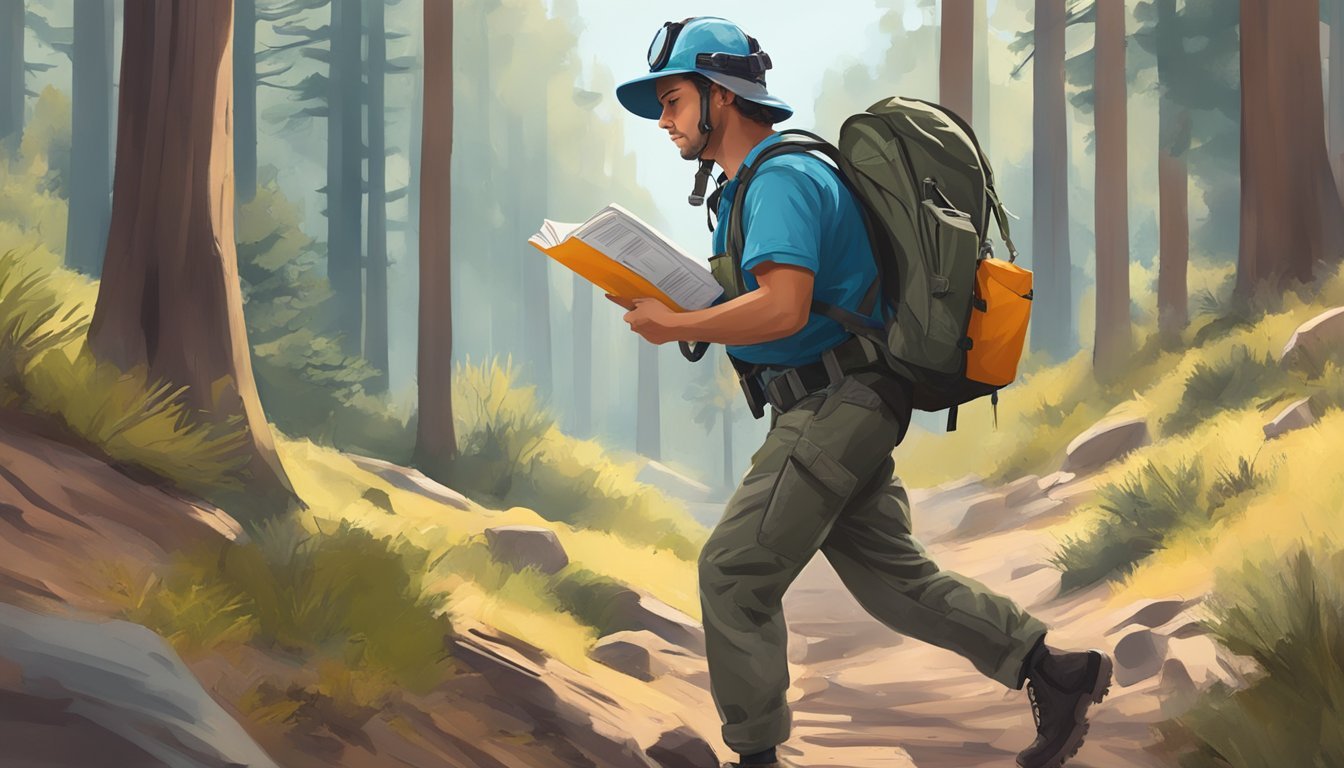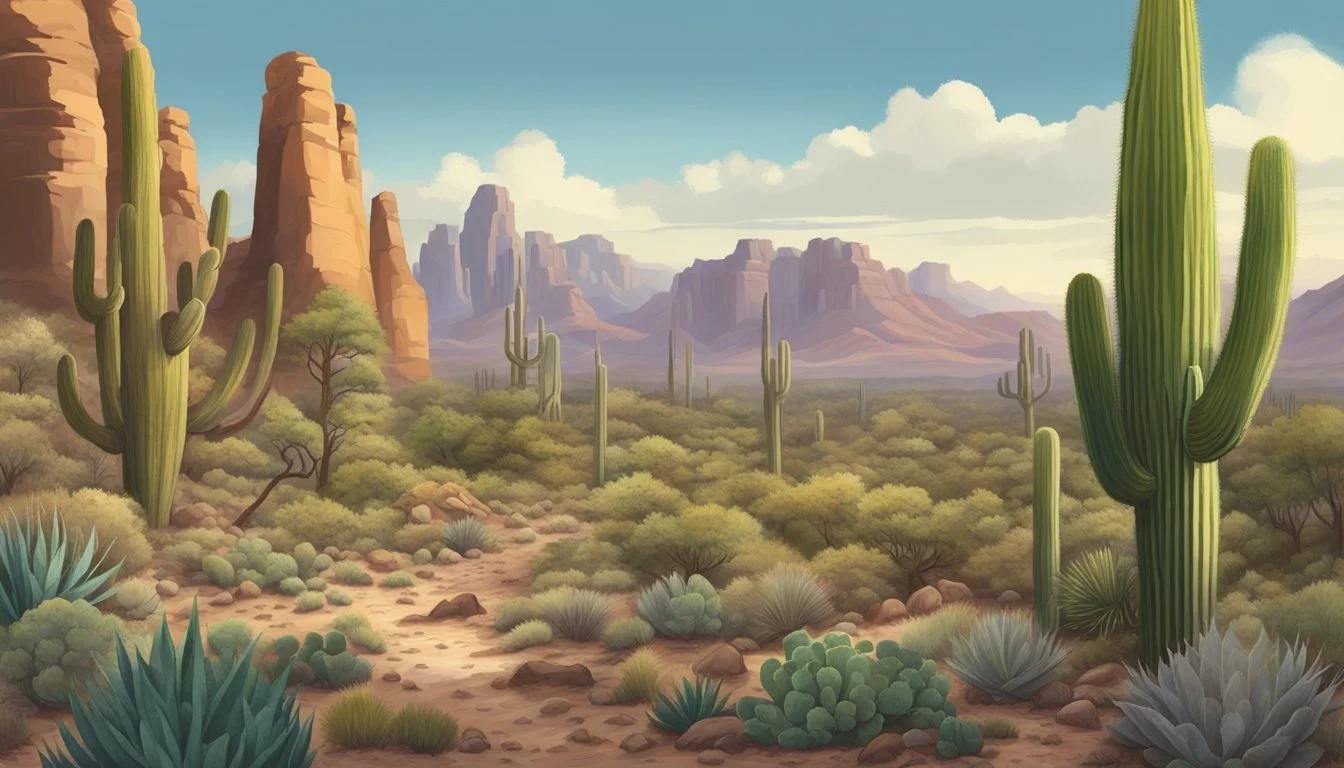Mushroom Hunting Arizona
Essential Tips for Safe Foraging
This Article is Part of Our Guide on Mushroom Hunting for All 50 States
Mushroom hunting in Arizona presents a unique opportunity for enthusiasts and novices alike to explore the state's diverse ecosystems. Despite the widespread perception of Arizona as a desert landscape, the state boasts a variety of climates that are conducive to mushroom growth, particularly in its forests and woodlands. As such, Arizona has become an appealing destination for those interested in mycology—the study of fungi—and for foragers pursuing the thrill of finding and identifying wild mushrooms.
The pursuit of wild mushrooms in Arizona requires knowledge of the state's distinct seasons and habitats. The monsoon season, for example, which typically runs from mid-summer to early fall, creates moist conditions ideal for the emergence of a range of mushroom species. During this time, mushroom hunters can expect to find varieties such as the flavorful morels, including Yellow Morel, Mountain Blond, and Black Morel, along with other species like the Turkey-tail Mushroom and Oyster Mushrooms. The varied terrain, from high elevation forests to riparian zones, supports this mycological diversity, reinforcing Arizona's status as a surprising but fruitful mushroom hunting ground.
Safety and conservation are paramount in mushroom foraging in Arizona. Foragers are advised to equip themselves with a solid understanding of which mushrooms are safe to consume and to always err on the side of caution, as some mushrooms can be toxic. Respect for the environment and adherence to sustainable foraging practices ensure that the mushroom populations and their habitats remain intact for future generations of hunters and nature enthusiasts. With the right approach, mushroom hunting in Arizona can be a rewarding activity, offering a way to connect with nature, expand one's mycological knowledge, and perhaps even enjoy the delights of a wild-harvested meal.
Foraging for More Than Just Mushrooms in Arizona
Arizona's diverse landscapes, from the Sonoran Desert to the Coconino National Forest, offer a unique array of wild edibles for the adventurous forager. While mushrooms are a sought-after find, the Grand Canyon State's rich ecosystems provide a bounty of desert fruits, nuts, greens, and roots. Discover the flavors of the Southwest and connect with nature through foraging in Arizona's picturesque wilderness, from the saguaro-studded hills of the Sonoran Desert to the ponderosa pine forests of the Mogollon Rim.
👉 Foraging for Wild Edibles in Arizona
Commonly Found Edible Mushrooms in Arizona
Arizona is home to several edible mushroom species. Some of the most commonly found edible mushrooms in the state include:
Meadow mushroom (Agaricus campestris): This edible mushroom is commonly found in Arizona and has a mild, nutty flavor, making it a popular choice for foragers.
Phoenix oyster (Pleurotus pulmonarius): Similar to the more common oyster mushroom, this variety is also found in Arizona and has a delicate flavor and tender texture.
Gem-studded puffball (Lycoperdon perlatum): Commonly found in Arizona, this mushroom is known for its pear-shaped fruiting body and edible, tender interior when young.
Horse mushroom (Agaricus arvensis): With its large size and mild flavor, this edible mushroom is frequently found in Arizona's grassy areas and open woodlands.
Barrow's bolete (Boletus barrowsii): This mushroom, found in Arizona, has a distinctive reddish-brown cap and a mild, nutty flavor, making it a sought-after find for mushroom enthusiasts.
Morels (Morchella spp): These highly prized mushrooms have a honeycomb appearance and are a favorite among foragers. In Arizona, one can find both yellow and black morels thriving in forested areas. Morels are often found in areas that have been burned by forest fires the previous year.
King Bolete (Boletus edulis): Known locally as Boletus barrowsii or white king bolete, these mushrooms are celebrated for their delicious flavor. Distinct for their large, rounded caps and stout stems, king boletes are a delightful find for any mushroom hunter.
Oyster Mushrooms (Pleurotus spp): These mushrooms grow in shelf-like formations on the sides of trees and are characterized by their oyster-shaped caps. They are common and versatile in the kitchen.
Kaibab Slippery Jack (Suillus kaibabensis): These mushrooms are typically found under conifers and are recognized by their sticky caps and ring around the stem, also known as an annulus.
It is essential to properly identify any mushroom before consuming it, as some species can be poisonous. Beginners should go mushroom hunting with an experienced guide or join a local mycological society to learn how to identify edible mushrooms safely.
Getting Started with Mushroom Hunting
Embarking on a mushroom hunting adventure in Arizona requires a foundation of knowledge coupled with essential equipment. This section provides the necessary insights and tools needed to begin the journey.
Understanding the Basics
To succeed in mushroom hunting, one needs to recognize the importance of timing and location. Arizona's diverse climates influence the mushroom season, which generally peaks during the monsoon months from July to September. Utilizing specific mushroom maps tailored to Arizona can vastly improve a hunter's chances of finding mushrooms. Additionally, consulting a reputable field guide enhances one's understanding of the native species and their habitats.
Peak Months: July-September (monsoon season).
Mushroom Types: Research species you’re likely to encounter in Arizona.
Equipment Essentials
The right equipment is paramount for an efficient and safe mushroom hunting experience. One should equip themselves with a durable basket or breathable bag to allow spores to disperse as they walk, a knife for clean cuts, a brush for dirt removal, and comfortable attire suitable for outdoor conditions. Carrying a GPS or a map with marked mushroom-rich areas can be significant, and a field guide for accurate identification is a must.
Mushroom Hunting Gear:
Equipment Purpose Basket/Bag Collect and carry mushrooms, spore dispersion Knife Harvest mushrooms cleanly Brush Clean mushrooms in the field Comfortable Attire Address variable outdoor conditions GPS/Map Navigate to promising locations Field Guide Identify mushrooms correctly
Mushroom hunters must prioritize safety by understanding their equipment and having a strong grasp of the types of mushrooms they are searching for.
Biology of Mushrooms
Mushrooms, the fruiting bodies of fungi, are a diverse group of organisms that play vital roles in ecosystems, especially in association with trees. They can range from the delectable oyster mushrooms to the sought-after morels.
Fungi Fundamentals
Fungi are a kingdom of non-photosynthetic organisms that include molds, yeasts, and mushrooms. Mushrooms are the reproductive structures of some fungi, designed to release spores into the environment. A mushroom's life cycle encompasses several stages:
Spore germination: Spores dispersed from mature mushrooms germinate under suitable conditions.
Mycelial growth: The spores grow into a network of cells called mycelium, which absorb nutrients from the environment.
Fruiting: Once conditions are right, the mycelium develops a fruiting body, the actual mushroom.
Spore release: The fruiting body releases spores to start the cycle anew.
Ecologically, mushrooms contribute to the decomposition of organic matter, thus being quintessential in nutrient cycling. Some mushrooms, like oyster mushrooms (Pleurotus ostreatus) and shaggy mane (Coprinus comatus), are saprotrophic, breaking down dead organic material, while others form symbiotic partnerships with live trees.
Tree Associations
Fungi, especially mushrooms, often form symbiotic relationships with trees through mycorrhizal associations. These are mutually beneficial relationships in which:
The fungus expands the effective root system of the tree, aiding in water and nutrient uptake.
Trees provide carbohydrates that fungi require for energy, derived from photosynthesis.
There are several types of mycorrhizal associations, and the tree species involved influence the type of mushrooms that may grow:
Ectomycorrhizal fungi associate with trees like oaks and conifers such as spruce. They envelop the tree roots but do not penetrate the root cells.
Arbuscular mycorrhizal fungi penetrate the root cells, creating a more intimate connection with the tree.
Specific pairings are known, such as morels often being found in association with ash or apple trees, and oyster mushrooms frequently growing on dead or dying aspen and other hardwoods. Recognizing these associations helps mushroom hunters locate target species. Fruiting typically occurs when the environmental conditions—temperature, moisture, and season—are just right, though some trees and fungi have more specific requirements that can affect fruiting schedules and locations.
Safety and Regulations
When engaging in mushroom hunting in Arizona, it is crucial that collectors prioritize safety by correctly identifying species and understand the legal framework that governs the collection of wild mushrooms.
Identifying Poisonous Varieties
The identification of poisonous mushrooms is paramount for safety. One well-known toxic species is Amanita muscaria. It is critical for hunters to recognize that while some mushrooms may appear similar to edible varieties, they can be dangerous if consumed. Hunters should employ field guides, participate in local forays with experts, and potentially consult resources from organizations like the Arizona Mushroom Society to ensure accurate identification.
Common Poisonous Mushrooms Distinguishing Features Notes Amanita muscaria Bright red cap with white spots Often found near pine and birch trees Galere Smooth, brown or yellow cap Can be confused with Chanterelles
Legal Considerations
Mushroom hunters in Arizona must adhere to state and federal laws that regulate foraging on public and private lands. Hunters should obtain necessary permissions or permits where required. Trespassing on private property without consent, or removing mushrooms from protected areas, is illegal. Hunters are advised to consult the Arizona Game & Fish Department for regulations related to the season and harvesting of mushrooms. It's also prudent to keep abreast of any changes in legislation or local guidelines that may affect mushroom hunting.
Best Practices for Foraging
Foraging for mushrooms in Arizona requires careful planning and ecological awareness to ensure a safe and fruitful endeavor.
Timing Your Hunt
Best Time: The most successful hunts coincide with optimal seasonal and climatic conditions. Arizona's mushroom season is influenced by the monsoon rains, usually starting in July and lasting through September, though some species may be available outside these months.
Spring: Certain edible mushrooms thrive in spring. Foragers should note the specific growth period of their target species to time their hunt accordingly.
Aspect & Slope: The orientation and incline of terrain affect microclimates and moisture retention, which in turn influences where and when mushrooms grow. North-facing slopes are cooler and moister, making them ideal for foraging during drier months.
Ecological Considerations
Soil Type: The health and type of soil significantly affect mushroom emergence. Foragers should familiarize themselves with the soil preferences of different mushroom species to increase hunt success rates.
Conservation: Foragers must practice sustainability by not overharvesting and by minimizing disturbance to the habitat.
Avoid picking young, immature specimens to allow them to spore.
Harvest selectively, leaving enough mushrooms to ensure continued growth.
Mushroom Varieties in Arizona
Arizona offers a diverse range of mushrooms across its varied landscapes. From the sought-after edibles like morels to the non-edible yet visually striking species, Arizona's fungi present an exciting opportunity for both novice and experienced mushroom hunters.
Notable Non-Edibles
Lobster Mushroom (Hypomyces lactifluorum): This is not a true mushroom but a fungal parasite that grows on other mushrooms, giving the host a reddish, lobster-like appearance. While it can be eaten, it's important to correctly identify the host mushroom as edible before consumption.
Non-edible species like the picturesque Hairy Curtain Crust (Stereum hirsutum) and vibrant Witch's Butter (Tremella mesenterica) are also found in Arizona, but these should not be consumed and are noted here for identification purposes only.
Locations and Habitats
Mushroom hunters in Arizona will find that the state's diverse landscapes offer a variety of habitats where mushrooms thrive, particularly in forested areas and unique ecosystems.
Forests and Mountains
In Arizona's forests and mountain regions, the conditions for mushroom growth are robust, with a good balance of moisture, shade, and forest litter. Hunters often explore the coniferous, beech, and oak woodlands in the higher elevations, as these environments foster a range of mushroom species. The sky islands, or isolated mountain ranges, of southeastern Arizona, with their distinct biospheres, are particularly renowned for their fungal diversity. Notable forested areas conducive to mushrooms include:
Coconino National Forest: Home to pine forests and higher humidity.
Apache-Sitgreaves National Forest: Abundant with mixed-conifer forests.
Santa Catalina Mountains: Representing sky island ecosystems with unique species.
Unique Arizona Ecosystems
Aside from the forested mountains, Arizona's unique ecosystems like the Sonoran Desert also support specific types of fungi. While mushroom hunters may not find the same abundance as in moist forested areas, some mushrooms do adapt to these arid conditions. They may appear quickly after rainfalls, which provide the necessary moisture for a brief yet productive growing period. Key environments include:
Chiricahua Mountains: Another example of a sky island with a variety of elevations and habitats.
Sonoran Desert: Though it's a desert, the monsoon season can spur sudden mushroom growth.
Hunters should pay attention to seasonal variations and elevational differences within these areas, as they can greatly influence both the presence and types of mushrooms found.
Arizona Mushroom Society
The Arizona Mushroom Society stands as a cornerstone for mycology enthusiasts and researchers in Arizona, offering structured events and opportunities for members to engage with the fungal kingdom. Through its affiliation with the North American Mycological Association, the society fosters a community dedicated to mushroom appreciation and education.
Community Events and Forays
The Society organizes numerous forays – guided mushroom hunting excursions – throughout the year, catering to both novice enthusiasts and seasoned mycologists. These events serve as an excellent opportunity for members to explore Arizona's diverse habitats, from its lush forests to the more unexpected woodland areas where various mushroom species thrive. Each foray is designed to provide practical, hands-on learning experiences about local fungi, their habitats, and the essentials of responsible and sustainable mushroom hunting.
Membership Benefits
Members of the Arizona Mushroom Society enjoy a range of benefits that enhance their understanding and appreciation of mushrooms. The Society grants access to an exclusive library of resources that includes scientific literature, identification guides, and historical mycological information. Furthermore, the Society offers educational meetings and lectures from experts in the field, enabling members to delve deeper into mycological study. Membership within the Society not only broadens individuals' fungal knowledge but also connects them with a network of like-minded enthusiasts within Arizona's mycological community.
Utilizing Resources
When venturing into mushroom hunting in Arizona, successful foragers rely on accurate navigational tools and educational materials. These resources not only enhance the efficiency of their searches but also ensure their safety and a deeper understanding of the diverse fungal flora in the region.
Navigational Tools
Mushroom Maps: Foragers often utilize detailed mushroom maps to identify potential hotspots for various species. These maps can be found online, in field guides, or through local mycological societies. They usually cross-reference mushroom habitats with topographical features, ensuring foragers can navigate to areas with a higher likelihood of fruitful yields.
GPS Devices: A reliable GPS device is indispensable for pinpointing precise locations. They access comprehensive databases and satellite imagery to provide accurate topographical information. These are especially useful in the vast and sometimes rugged landscapes of Arizona's forests.
Educational Materials
Field Guides: A robust field guide is an essential tool for mushroom hunters. The best guides include:
High-resolution images
Descriptions of habitat
Seasonal availability
Edibility status
These guides give foragers the knowledge to identify mushrooms accurately, differentiate between edible and poisonous varieties, and understand each species' ecological role.
Libraries and Local Societies: Libraries and local mycological societies are invaluable sources for both beginners and seasoned foragers. They provide access to a wealth of books and periodicals on mycology, and they may also offer seminars and events aimed at educating the public on safe and sustainable mushroom hunting practices. The Arizona Mushroom Society, for instance, is a well-regarded resource for educational meetings and forays.
After the Hunt
Properly caring for and storing mushrooms after the hunt is crucial to maintaining their quality and safety. The transition from the forest to the kitchen involves two main processes: ensuring optimal preservation and preparing mushrooms for consumption.
Mushroom Care and Storage
Immediate Handling: Mushrooms should be kept cool and clean as soon as they are picked. They are best stored in a ventilated container such as a paper bag or a basket.
Cleaning: Gently brush off any dirt with a soft brush. Avoid washing unless necessary, as moisture can hasten spoilage.
Refrigeration: Store mushrooms in the refrigerator to slow down the decomposition process. Ideal temperature is 34-38°F.
Duration: Most fresh mushrooms can last up to one week in the refrigerator if handled correctly.
Cooking and Preservation
Cooking: Mushrooms should be cooked thoroughly to enhance flavor and digestibility. Popular methods include sautéing, grilling, and roasting.
Preservation: For long-term storage, mushrooms can be either dried, pickled, or frozen.
Drying: Spread mushrooms in a single layer and air-dry or use a food dehydrator at 110-120°F until crisp.
Pickling: Mushrooms can be preserved in a vinegar-based solution with spices, to be consumed within a few months.
Freezing: After blanching in boiling water for 2-3 minutes, cool mushrooms in ice water, drain, and freeze in airtight containers or freezer bags.





